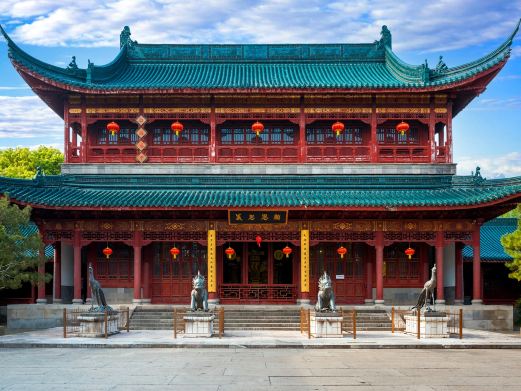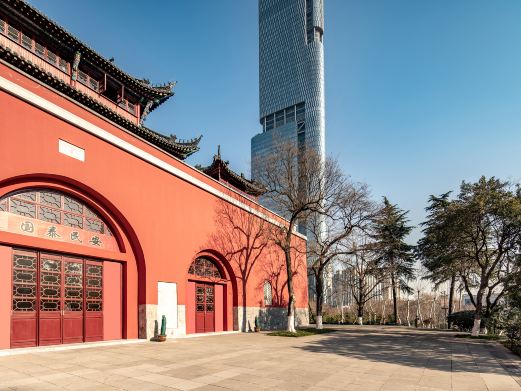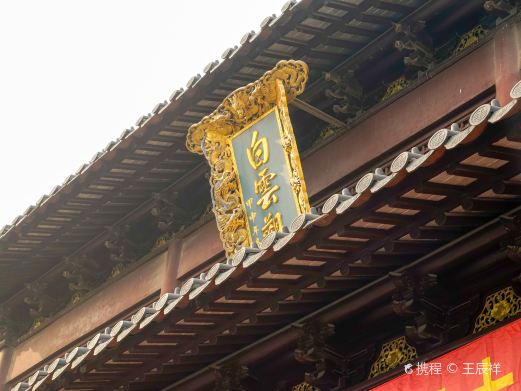Performance
25th Anniversary of Creation – Stan Lai’s Panoramic Life Epic at the 2025 Theatre ‘What could theatre possibly be?’ In 2000, Chinese playwright Stan Lai, with nearly 20 years of theatre creation under his belt, began to question himself anew. ‘Dream of Dreams’ was born at the turn of the century in 2000, innovatively and comprehensively answering this question. The creation of ‘Dream of Dreams’ was a slow-cooking inspiration for Lai: during a trip to Europe, he saw a painting by Jan Brueghel the Elder, which depicted an entire wall of paintings on display. This ‘painting within a painting’ inspired a lengthy play title in Lai’s mind: ‘In a story, someone had a dream; in that dream, someone told a story.’ Later, during a trip to India, he observed monks circumambulating the most sacred stupa, moving in and out around it. What is the most sacred in the theatre? This question resurfaced, and the answer was the audience. Boldly placing the audience at the center of the stage, with actors circling the audience, Lai created a ‘lotus pond’ and pioneered the circular theatre. It was also during this trip to India that past life experiences and heard stories all connected. Under the Bodhi tree in Bodh Gaya, Lai completed the outline of ‘Dream of Dreams.’ The story spans from Taipei to Paris and then to Shanghai; from the 20th to the 21st century, crossing a century, Lai takes us on a ‘panoramic’ journey into the lives of many characters within the play. Theatre and film critic Zhou Liming once commented on ‘Dream of Dreams’: ‘It is a significant milestone in Chinese theatre and possibly the greatest Chinese play ever written.’ In an instant, a dream spans twenty-five years. The year 2025 marks the 25th anniversary of the creation of ‘Dream of Dreams.’ A flash of inspiration on November 10, 1999, has allowed us to follow the dreamlike stories penned by Lai and reflect on life over the past 25 years. From January 23rd to 25th, the play, written and directed by Stan Lai, features renowned actors Ni Ni (playing Gu Xianglan C), Wen Zhang (playing Wu Hao B), young actors Zhao Xiaosu (playing Wang Debao A), Zong Juntao (playing Wang Debao B), and Feng Li (playing Jiang Hong). Special guest appearances by Liu Wanling (playing Gu Xianglan A) and Fan Guangyao (playing the Count), with all actors from the Shang Theatre Troupe, and ‘Fashion Goddess’ Huang Wei in charge of costume design.In 2025, at the Shang Theatre, join us once again for a story of ‘seeing oneself’, as we step into a dream within a dream.
The plot begins with a newly employed ‘novice’ doctor. On her first day at work, Dr. Xiaomei encounters the separation and death of patients and their families, struggling to cope with the immediate confrontation of life and death after graduating from medical school. She meets a patient in bed number five, who suffers from an undiagnosed strange illness and seems burdened with心事. The doctor hopes to find a breakthrough from him, using a method of ‘self-other exchange’: breathing towards the patient to give him her happiness and absorb his pain. With her persistence, the ‘number five’ patient finally begins to tell his story. Within ‘number five’s’ narrative, we follow his steps into his life, his life with his wife, and his gradually vanishing peaceful existence. From here, he embarks on an unbelievable journey while seeking a cure, carrying a painting to find the person within it. From Taipei to Paris and then to Shanghai, he searches for the person in the painting, ‘Gu Xianglan’, who can provide answers. The life of Gu Xianglan, once the top performer at the ‘Tianxiang Pavilion’ in 1930s Shanghai, is filled with splendor and turmoil, ultimately finding completion in ‘number five’s’ search. In the nearly eight-hour story, the tales of two lifetimes unfold slowly. Amid the interplay of dreams and reality, a mandala-like series of life stories unfolds. Playwright and Director ⊙ Stan Lai, Co-director ⊙ Luan Lan, Performances by ⊙ Ni Ni, Feng Li, Liu Wanling, Dou Jin, Gu Xuewei, Jin Jing, Li Aini, Ma Jingwen, Si Wen, Ding Shanshan, He Panpan, Ni Shunjie, Chen Yifei, Zhao Xiaobin, Wen Zhang, Fan Guangyao, Zhao Xiaosu, Zong Juntao, Yang Yi, Wang Meng, Weng Leibin, Yuan Xinli, Cui Zongren, Yang Yuguang, Chen Guohui, Feng Yugang, Wang Bingkun, Cai Xuhao, Qi Le, Stage Design ⊙ Stan Lai, Costume and Styling Design ⊙ Huang Wei, Lighting Design ⊙ Zeng Tianxiao, Original Music ⊙ Hong Yutong, Lai Shengchuan, Hu Shuai, Poster Design ⊙ Huang Hai, Supervision ⊙ Ding Naizhu. Performance Review: This is a performance about time, against time, and eternity… Stan Lai leads generation after generation of theater audiences into his soul universe… into his absolute theater dream. (‘Dream of Dreams’) deserves to be collected in a special collection, alongside the works of other contemporary geniuses such as Silviu Purcarete, Jan Fabre, Julie Taymor, Robert Wilson, Robert Lepage, Theodoros Terzopoulos, etc.Watching this drama is a blessing and a granted grace. It is also an experience that transforms human nature. It affirms the value of the theater as a rare opportunity to rediscover human nature. —Audavien Sayu, president of the International Association of Theater Leaders (IATL). A major milestone in Chinese drama and perhaps the greatest Chinese drama ever. —Zhou Liming, drama and film critic. ‘A Dream Like a Dream’ may be the work with the most cosmopolitan view in Chinese drama… This kind of richness is very rare. It can only be witnessed in works with great breadth and depth created by artists whose artistic heights may confuse ordinary audiences. —China Daily. This is a work full of spirituality, thinking and creativity… ‘A Dream Like a Dream’ shows the local life experience under cultural conflicts and exchanges in the context of globalization in the 20th century, full of attention to individuals and life. —People’s Daily. Based on the ‘art of time and space’ of drama, it is not limited by the time and space in common sense. It completely creates a new time and space for drama. ‘A Dream Like a Dream’ has true meaning, making people want to argue but forget words. —Zhu Guang, Xinmin Evening News. This may be Lai Shengchuan’s play with the least laughter, but there is also full of joy from time to time. This may be Lai Shengchuan’s play with the most profound life artistic conception, but it can also make everyone feel themselves. In the dream that rotates like a top, the eight-hour life in various states is not long when condensed. After entering the situation, you would rather this eight-hour broken dream not wake up. —The Beijing News. This is a bold breakthrough and a profound journey. It is not the exploration of a novice, but the confident self-transcendence of a mature artist. In terms of subject matter, Lai Shengchuan bravely quotes a large amount of Buddhist teachings that he has studied for many years. In terms of form, it is the sum of all his past attempts and surpasses all of these… He has created a new form of theater in the Chinese language world. —Tao Qingmei, a theater researcher at the Chinese Academy of Social Sciences. This work breaks the routine of theater performances, but makes the audience still want more… This classic masterpiece creates exciting and surprising creativity. —Jonathan Gelb, drama critic. ‘A Dream Like a Dream’ is a masterpiece waiting to go to the West… It is not only a heavyweight performance that causes a sensation in China, but also an international art work that insists on having an impossible dream. —Anna Milib Kristiansen, Izvestia. The most peculiar thing about ‘A Dream Like a Dream’ is that it completely subverts the inherent model of actors in front and audiences behind watching a play in the theater as if ‘watching the fire from the other side of the river’… Lai Shengchuan carefully manages the 360-degree stage space. In the end, the delicate and plain content controls the form.
—Ding Chenxin, China Newsweek. In his plays, everything is subtle and changing. Everything also has profound and complex multiple meanings. Stan Lai’s dramatic language cannot be imitated. One role is played by several people and appears on the same stage at the same time. In fact, it is a fierce competition of skills. But the situation where there is a self in the role and it does not deviate reflects the sense of hierarchy of the ‘epic journey symphony’ as mentioned by Mao Junhui. —Hong Kong Economic Times. The epic characteristic of ‘A Dream Like a Dream’ is not its length and scale, but the depth and breadth of its cultural ambition. —The Straits Times. The stage performs around the audience on all sides. It is as if the audience is in a fish pond and looks out from the inside. They are moved by the entire play. Thinking it is talking about the past, in fact, it is talking about the present. The audience frequently looks around. The audience needs to look for the performers. It is different from the traditional audience looking at the performance in front. However, the audience will involuntarily enter into the story and have the effect of participation. Moreover, the audience can turn around in all directions and is more easily moved.
Opening hours: January 23rd – January 25th. The performance time and duration are subject to the site.








